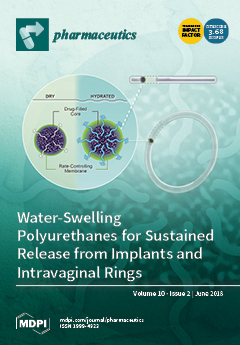Open AccessArticle
A Miniaturized Extruder to Prototype Amorphous Solid Dispersions: Selection of Plasticizers for Hot Melt Extrusion
by
Matthias E. Lauer, Reto Maurer, Anne T. De Paepe, Cordula Stillhart, Laurence Jacob, Rajesh James, Yuki Kojima, Rene Rietmann, Tom Kissling, Joost A. Van den Ende, Sabine Schwarz, Olaf Grassmann and Susanne Page
Cited by 10 | Viewed by 5158
Abstract
Hot-melt extrusion is an option to fabricate amorphous solid dispersions and to enhance oral bioavailability of poorly soluble compounds. The selection of suitable polymer carriers and processing aids determines the dissolution, homogeneity and stability performance of this solid dosage form. A miniaturized extrusion
[...] Read more.
Hot-melt extrusion is an option to fabricate amorphous solid dispersions and to enhance oral bioavailability of poorly soluble compounds. The selection of suitable polymer carriers and processing aids determines the dissolution, homogeneity and stability performance of this solid dosage form. A miniaturized extrusion device (MinEx) was developed and Hypromellose acetate succinate type L (HPMCAS-L) based extrudates containing the model drugs neurokinin-1 (NK1) and cholesterylester transfer protein (CETP) were manufactured, plasticizers were added and their impact on dissolution and solid-state properties were assessed. Similar mixtures were manufactured with a lab-scale extruder, for face to face comparison. The properties of MinEx extrudates widely translated to those manufactured with a lab-scale extruder. Plasticizers, Polyethyleneglycol 4000 (PEG4000) and Poloxamer 188, were homogenously distributed but decreased the storage stability of the extrudates. Stearic acid was found condensed in ultrathin nanoplatelets which did not impact the storage stability of the system. Depending on their distribution and physicochemical properties, plasticizers can modulate storage stability and dissolution performance of extrudates. MinEx is a valuable prototyping-screening method and enables rational selection of plasticizers in a time and material sparing manner. In eight out of eight cases the properties of the extrudates translated to products manufactured in lab-scale extrusion trials.
Full article
►▼
Show Figures






